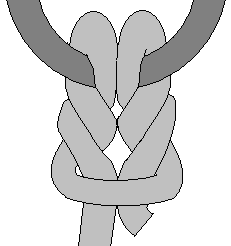AY Honors/Knot/Cat's paw
The cat's paw is a knot (specifically, a hitch).
Canonical Name
Cat's paw.
Variant Names
None.
Category
Origin
Ancient.
Related knots
The Cat's paw is very similar to the girth hitch/lark's foot/cow hitch except there is an additional turn on each side of the bight, making it less prone to slipping. (The cow hitch, girth hitch and lark's foot are alternative names for the same knot.)
Releasing
Non-jamming in the standard form. When tension is removed it is easy to undo the knot. In a variant with multiple turns, it may tend to jam.
Efficiency
Unknown.
Uses
- Attaching a rope to a hook (or to a post or rail where the load is perpendicular to the post) with more security than a simple girth hitch.
- Joining an eye to a ring.
- Strongly joining eyes in the ends of two lines, where there is access to the end of at least one line.
Comments
In one method of tying, it can be pre-formed in the middle of the rope, then slid over the end of a post or rail.
In an alternative method, a line with an accessible end and an eye can be attached to another eye, ring or rail with inaccessible ends.
Structure
Formed from a bight turned up over itself (like a girth hitch) but with an extra turn on each side. In variations, there may be multiple extra turns.
Tying
Method 1
Form a bight in the middle of the line, and pull it back over itself like a girth hitch. This forms two loops, turned in opposite directions. Give each loop one more full turn in the direction that will tend to tighten it (the wrong direction will undo the loop completely). Pass both loops over the hook, rail or post and pull tight, taking care to push the bight up snugly against the turns.
Method 2
If working end of the line has an eye in it, and the standing end is accessible, the knot can be tied to a closed ring, another eye, or a rail with inaccessible ends, as follows. Pass the eye around the ring or rail, then pass the standing end through its own eye (this effectively forms a girth hitch). Then pass the standing end through the eye again, and pull up tight, taking care to push the bight up snugly against the turns.
When using the cat's paw to join two eyes, this process may be repeated several times to give several turns - as many as five in a fine fishing monofilament. Then when tightened, instead of pulling the bight up against the turns, both eyes are pulled equally, to make neat coils of turns in both eyes, meeting halfway between them.

